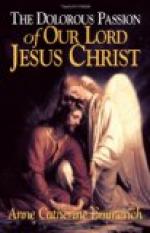The complexion of our Lord was fair, like that of Mary, and slightly tinted with red; but his exposure to the weather during the last three years had tanned him considerably. His chest was wide, but not hairy like that of St. John Baptist; his shoulders broad, and his arms and thighs sinewy; his knees were strong and hardened, as is usually the case with those who have either walked or knelt much, and his legs long, with very strong muscles; his feet were well formed, and his hands beautiful, the fingers being long and tapering, and although not delicate like those of a woman, still not resembling those of a man who had laboured hard. His neck was rather long, with a well-set and finely proportioned head; his forehead large and high; his face oval; his hair, which was far from thick, was of a golden brown colour, parted in the middle and falling over his shoulders; his beard was not any great length, but pointed and divided under the chin. When I contemplated him on the cross, his hair was almost all torn off, and what remained was matted and clotted with blood; his body was one wound, and every limb seemed as if dislocated.
The crosses of the two thieves were placed, the one to the right and the other to the left of Jesus; there was sufficient space left for a horseman to ride between them. Nothing can be imagined more distressing than the appearance of the thieves on their crosses; they suffered terribly, and the one on the left-hand side never ceased cursing and swearing. The cords with which they were tied were very tight, and caused great pain; their countenances were livid, and their eyes enflamed and ready to start from the sockets. The height of the crosses of the two thieves was much less than that of our Lord.
CHAPTER XLII.
First Word of Jesus on the Cross.
As soon as the executioners had crucified the two thieves and divided the garment of Jesus between them, they gathered up their tools, addressed a few more insulting words to our Lord, and went away. The Pharisees, likewise, rode up to Jesus, looked at him scornfully, made use of some opprobrious expression, and then left the place. The Roman soldiers, of whom a hundred had been posted round Calvary, were marched away, and their places filled by fifty others, the command of whom was given to Abenadar, an Arab by birth, who afterwards took the name of Ctesiphon in baptism; and the second in command was Cassius, who, when he became a Christian, was known by the name of Longinus: Pilate frequently made use of him as a messenger. Twelve Pharisees, twelve Sadducees, as many scribes, and a few ancients, accompanied by those Jews who had been endeavouring to persuade Pilate to change the inscription on the Cross of Jesus, then came up: they were furious, as the Roman governor had given them a direct refusal. They rode round the platform, and drove away the Blessed Virgin, whom St. John led to the holy women. When they passed the Cross of Jesus, they shook their heads disdainfully at him, exclaiming at the same time, ’Vah! thou that destroyest the temple of God, and in three days buildest it up again, save thyself, coming down from the Cross. Let Christ, the King of Israel, come down now from the Cross, that we may see and believe.’ The soldiers, likewise, made use of deriding language.




